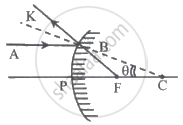Advertisements
Advertisements
Question
Answer the following question in detail.
What is a terrestrial telescope and an astronomical telescope?
Solution
- Telescopes used to see the objects on the Earth, like mountains, trees, players playing a match in a stadium, etc. are called terrestrial telescopes.
- In such a case, the final image must be erect. The eye lens used for this purpose must be concave and such a telescope is popularly called a binocular.
- Most of the binoculars use three convex lenses with proper separation. The image formed by the second lens is inverted with respect to the object. The third lens again inverts this image and makes the final image erect with respect to the object.
- An astronomical telescope is the telescope used to see objects like planets, stars, galaxies, etc. In this case, there is no necessity for an erect image. Such telescopes use a convex lens as an eye lens.
APPEARS IN
RELATED QUESTIONS
Answer the following question in detail.
Define and describe the magnifying power of an optical instrument.
Answer the following question in detail.
Derive an expression for the magnifying power of a simple microscope. Obtain its minimum and maximum values in terms of its focal length.
Answer the following question in detail.
Obtain the expressions for magnifying power and the length of an astronomical telescope under normal adjustments.
Answer the following question in detail.
What is the limitation in increasing the magnifying powers of a simple microscope?
Answer the following question in detail.
What is the limitation in increasing the magnifying powers of a compound microscope?
Answer the following question in detail.
What is the limitation in increasing the magnifying powers of the astronomical telescope?
Why is oil-immersed objective preferred in a microscope?
What are the uses of spectrometer?
What is myopia?
What is hypermetropia?
What is presbyopia?
What is astigmatism? What is its remedy?
Discuss about simple microscope and obtain the equations for magnification for near point focusing and normal focusing.
Obtain the equation for resolving the power of the microscope.
Explain the preliminary adjustments of the spectrometer.
A compound microscope has a magnification of 30. The focal length of eye piece is 5 cm. Assuming the final image to be at least distance of distinct vision, find the magnification produced by the objective.
The near point and the far point for a person are 50 cm and 500 cm, respectively. Calculate the power of the lens the person should wear to read a book held in hand at 25 cm. What maximum distance is clearly visible for the person with this lens on the eye?
A light wave of wavelength λ is incident on a slit of width d. The resulting diffraction pattern is observed on a screen at a distance D. If linear width of the principal maxima is equal to the width of the slit, then the distance D is
There are four convex lenses L1, L2, L3 and L4 of focal length 2, 4, 6 and 8 cm, respectively. Two of these lenses from a telescope of length 10 cm and magnifying power 4. The objective and eye lenses are respectively
When a convex lens of 12.5 cm focal length is used as a magnifying glass, normal eye can see an object clearly at a distance of 25 cm. The magnifying power of the instrument is ____________.
If astronomical telescope of length 1.53 m has magnifying power of magnitude 50, the values of fo and fe are ____________.
An object viewed from a near point distance of 25 cm, using a microscopic lens with magnification '6', gives an unresolved image. A resolved image is observed at infinite distance with a total magnification double the earlier using an eyepiece along with the given lens and a tube of length 0.6 m, if the focal length of the eyepiece is equal to ______ cm.
Magnification produced by astronomical telescope for normal adjustment is 10 and length of telescope is 1.1 m. The magnification when the image is formed at least distance of distinct vision (D = 25 cm) is ______.
In the adjoining figure, AB represents the incident ray, and BK is the reflected ray. If angle BCF = θ, then ∠BFP is given by ______.

